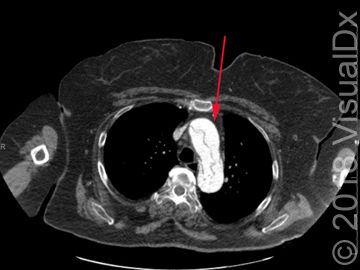Article
Image IQ: Ripping chest pain and leg weakness
A 58-year-old man went to the emergency department (ED) with chest pain he described as “ripping.” The pain radiated down his back. In the ED, he complained of abdominal pain and monoparesis of his left leg. What's your diagnosis?
(©VisualDx)

A 58-year-old man went to the emergency department (ED) with chest pain he described as “ripping.” It started suddenly as he was helping his wife move furniture. The pain radiated down his back. In the ED, he complained of abdominal pain and monoparesis of his left leg. The patient reported a history of cigarette smoking.
What's your diagnosis?
A. Myocardial infarction
B. Pulmonary embolism
C. Angina pectoris
D. Aortic aneurysm dissection
Use the differential builder on VisualDxto guide your decision.
See the next page for the answer.
The correct answer is D.) aortic aneurysm dissection
Synopsis
Aortic aneurysm dissection is an intramural tear of the aorta instigated by a dilation, or aneurysm, of the aorta. Aortic aneurysm dissection is a life-threatening emergency. Tears often occur in the intimal layer of the aorta, with blood collecting into the medial layer. Back pain is the common presenting symptom. Syncope and hypotension occur less frequently. Aortic dissections most often occur in older males. Most aortic aneurysms are asymptomatic before rupture or dissection. Etiology of the aortic aneurysm depends on its location. Ascending aortic aneurysms are primarily caused by medial degeneration in diseases such as Marfan syndrome. Descending aortic aneurysms are primarily caused by atherosclerosis.
Beta blockers are the primary medical treatment. Surgical intervention is indicated for many types of aortic dissection. Even with appropriate treatment, mortality from aortic aneurysm dissection is very high.
For more information about aortic aneurysm dissection, including ICD 10 codes, visit VisualDx.





